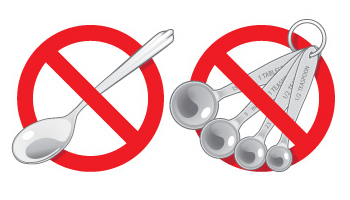Measuring Liquid Medicines

Never measure liquid medicines with household utensils. They are not uniformly sized and this will cause either too much or too little medication to be given. Household measuring or baking spoons also should not be used as the liquid may spill or it may be difficult for you to get the whole dose.
If you are told to take milliliters (mL), teaspoons (tsp), or tablespoons (Tbsp), always make sure you use a measuring device that is marked clearly with your dose.
Some oral measuring devices come with a combination of milliliters (mL), teaspoons (tsp), or tablespoons (Tbsp) markings. Make sure you ask your doctor or pharmacist which marking you should to use to measure your dose. You may find it easier to ask them for a device that only includes the marking you need.
Medicine Cups
Be sure to use the cup that comes with the medicine. These often come over the lids of liquid cold and flu medicines. Don’t mix and match cups to different products. You might end up giving the wrong amount.

Don’t just fill it up. Look carefully at the lines and letters on the cup. Use the numbers to fill the cup to the right line. Ask your pharmacist to mark the right line for your child if you are not sure. Be sure the cup is level. You can check by putting it on a flat surface.
Dosing Spoons

- Best for children who can drink from a cup, but often spill some liquid. This measuring device may be good for children who use sippy cups to drink liquid.
- Check for markings on the spoon that match the amount you need for your dose.
Droppers or Syringes

-
- Best for very young children who cannot drink from a cup
- Check for markings on the dropper or oral syringe that match the amount you need for your dose.

- NEVER use hypodermic syringes that are intended to give shots. Only use syringes made especially for oral use.
- Don’t put the medicine in the back of the throat. This could choke your child. Instead, squirt it gently between your child’s tongue and the side of the mouth. This makes it easier to swallow.
Tips
- 1 teaspoon (tsp) = 5 milliliters (mL)
- 3 teaspoons (tsp) = 1 tablespoon (tbsp)
- 1 tablespoon (Tbsp) = 15 milliliters (mL)
